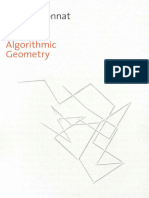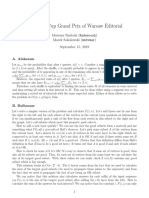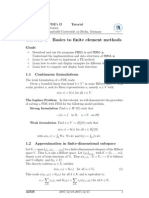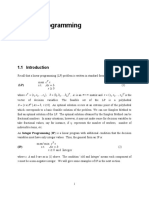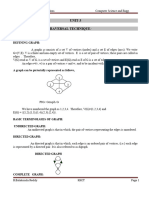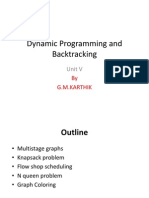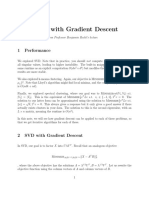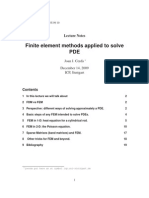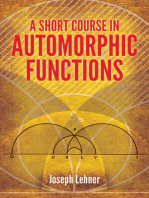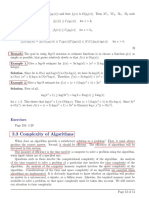Chapter - 12 (Dynamic Programming)
Uploaded by
JenberChapter - 12 (Dynamic Programming)
Uploaded by
Jenber1
Chapter 12
Dynamic Programming
Prepared By: Eyob S.
Introduction
2
It was invented by a prominent U.S. mathematician, Richard
Bellman, in the 1950s as a general method for optimizing
multistage decision processes.
Dynamic programming is a technique for solving problems with
overlapping sub problems. Typically, these sub problems arise
from a recurrence relating a given problem’s solution to solutions
of its smaller sub problems.
Rather than solving overlapping sub problems again and again,
dynamic programming suggests solving each of the smaller sub
problems only once and recording the results in a table from
which a solution to the original problem can then be obtained.
Prepared By: Eyob S.
The Knapsack Problem
3
Here we design a dynamic programming algorithm for the knapsack
problem: given n items of known weights w1, . . . , wn and values
v1, . . . , vn and a knapsack of capacity W, find the most valuable subset
of the items that fit into the knapsack.
We assume all the weights and the knapsack capacity are positive
integers; the item values do not have to be integers.
Let us consider an instance defined by the first i items, 1≤ i ≤ n, with
weights w1, . . . , wi, values v1, . . . , vi , and knapsack capacity j, 1 ≤ j ≤
W.
Let F(i, j) be the value of an optimal solution to this instance, i.e., the
value of the most valuable subset of the first i items that fit into the
knapsack of capacity j.
Prepared By: Eyob S.
Continued…
4
We can divide all the subsets of the first i items that fit the knapsack of
capacity j into two categories: those that do not include the i th item and
those that do.
Among the subsets that do not include the ith item, the value of an
optimal subset is, by definition, F(i − 1, j).
Among the subsets that do include the ith item (hence, j − wi ≥ 0), an
optimal subset is made up of this item and an optimal subset of the first
i − 1 items that fits into the knapsack of capacity j − wi . The value of
such an optimal subset is vi + F(i − 1, j − wi).
Thus, the value of an optimal solution among all feasible subsets of the
first i items is the maximum of these two values.
Prepared By: Eyob S.
Continued…
5
Example:
Prepared By: Eyob S.
Continued…
6
The dynamic programming table is filled as shown below :
capacity j
i 0 1 2 3 4 5
0 0 0 0 0 0 0
w1 = 2, v1 = 12 1 0 0 12 12 12 12
w2 = 1, v2 = 10 2 0 10 12 22 22 22
w3 = 3, v3 = 20 3 0 10 12 22 30 32
w4 = 2, v4 = 15 4 0 10 25 35 37 47
Prepared By: Eyob S.
Continued…
7
Thus, the maximal value is F(4, 5) = $47. We can find the composition of
an optimal subset by back tracing the computations of this entry in the
table.
Since F(4, 5) > F(3, 5), item 4 has to be included in an optimal solution
along with an optimal subset for filling 5 − 2 = 3 remaining units of the
knapsack capacity.
The value of the latter is F(3, 3). Since F(3, 3) = F(2, 3), item 3 need not be
in an optimal subset.
Since F(2, 3) > F(1, 3), item 2 is a part of an optimal selection, which
leaves element F(1, 3 − 1) to specify its remaining composition.
Similarly, since F(1, 2) > F(0, 2), item 1 is the final part of the optimal
solution {item 1, item 2, item 4}.
Prepared By: Eyob S.
Warshall’s Algorithm
8
Warshall’s algorithm is used for computing the transitive
closure of a directed graph.
Recall that the adjacency matrix A = {aij} of a directed graph
is the Boolean matrix that has 1 in its ith row and jth column if
and only if there is a directed edge from the ith vertex to the jth
vertex.
The transitive closure of a directed graph with n vertices can
be defined as the n × n Boolean matrix T = {tij}, in which the
element in the ith row and the jth column is 1 if there exists a
nontrivial path (i.e., directed path of a positive length) from
the ith vertex to the jth vertex; otherwise, tij is 0.
Prepared By: Eyob S.
Continued…
9
Prepared By: Eyob S.
Continued…
10
Example:
Use Warshall’s algorithm to find the transitive closure matrix
of the following digraph.
Prepared By: Eyob S.
Solution:
11
Prepared By: Eyob S.
Floyd’s Algorithm
12
Floyd’s algorithm is used for computing the all-pairs shortest-paths
problem.
Given a weighted connected graph (undirected or directed), the all-
pairs shortest paths problem asks to find the distances — i.e., the
lengths of the shortest paths — from each vertex to all other vertices.
Because of its important applications to communications,
transportation networks, and operations research, it has been
thoroughly studied over the years.
It is convenient to record the lengths of shortest paths in an n × n
matrix D called the distance matrix: the element dij in the ith row and
the jth column of this matrix indicates the length of the shortest path
from the ith vertex to the jth vertex.
Prepared By: Eyob S.
Continued…
13
Use Floyd’s algorithm to determine the distance matrix for the
following digraph.
Prepared By: Eyob S.
Solution
14
Prepared By: Eyob S.
15
Thank You!
Prepared By: Eyob S.
You might also like
- Algorithmic Geometry by Jean-Daniel Boissonnat, Mariette Yvinec, Herve BronnimanNo ratings yetAlgorithmic Geometry by Jean-Daniel Boissonnat, Mariette Yvinec, Herve Bronniman543 pages
- XX Open Cup Grand Prix of Warsaw Editorial: Mateusz Radecki (Radewoosh) Marek Sokolowski (Mnbvmar) September 15, 2019No ratings yetXX Open Cup Grand Prix of Warsaw Editorial: Mateusz Radecki (Radewoosh) Marek Sokolowski (Mnbvmar) September 15, 20199 pages
- Linear Methods of Applied Mathematics Evans M. Harrell II and James V. HerodNo ratings yetLinear Methods of Applied Mathematics Evans M. Harrell II and James V. Herod16 pages
- Chapter 7 Extremal Combinatorics FormattedNo ratings yetChapter 7 Extremal Combinatorics Formatted39 pages
- Chapter 7 - Poisson's and Laplace EquationsNo ratings yetChapter 7 - Poisson's and Laplace Equations19 pages
- Optimization I: Brute Force and Greedy Strategy: 3.1 Heuristic Search ApproachesNo ratings yetOptimization I: Brute Force and Greedy Strategy: 3.1 Heuristic Search Approaches13 pages
- Finite Element Method: X X X F N Da FN DV X FNo ratings yetFinite Element Method: X X X F N Da FN DV X F11 pages
- Unit 3 - Analysis and Design of Algorithm - WWW - Rgpvnotes.inNo ratings yetUnit 3 - Analysis and Design of Algorithm - WWW - Rgpvnotes.in11 pages
- Miersemann - Elliptic Partial Differential Equations of Second OrderNo ratings yetMiersemann - Elliptic Partial Differential Equations of Second Order87 pages
- 2022-2023 ICPC Latin American Regional Programming Contest - Unofficial EditorialNo ratings yet2022-2023 ICPC Latin American Regional Programming Contest - Unofficial Editorial10 pages
- Interpolation With Positive Real Functions OF Several VariablesNo ratings yetInterpolation With Positive Real Functions OF Several Variables12 pages
- Frenkel 5 Lectures On Soliton Equations, 1997No ratings yetFrenkel 5 Lectures On Soliton Equations, 199742 pages
- Introduction To Dynamic Programming: 20bits About WritingNo ratings yetIntroduction To Dynamic Programming: 20bits About Writing6 pages
- COMP 3250 B - Design and Analysis of Algorithms (Advanced Class)No ratings yetCOMP 3250 B - Design and Analysis of Algorithms (Advanced Class)2 pages
- Variables or Real Multivariate Function Is A Function With More Than One Argument, With AllNo ratings yetVariables or Real Multivariate Function Is A Function With More Than One Argument, With All8 pages
- Wavelets and Image Compression: Vlad Balan, Cosmin Condea January 30, 2003No ratings yetWavelets and Image Compression: Vlad Balan, Cosmin Condea January 30, 200320 pages
- Graph Isomorphism and Representation TheoryNo ratings yetGraph Isomorphism and Representation Theory7 pages
- Sample Problems in Discrete Mathematics: 1 Using Mathematical InductionNo ratings yetSample Problems in Discrete Mathematics: 1 Using Mathematical Induction5 pages
- Poisson's Equation by The FEM Using A MATLAB Mesh Generator: 4u F U 0 On DNo ratings yetPoisson's Equation by The FEM Using A MATLAB Mesh Generator: 4u F U 0 On D6 pages
- daa_02_R1_1_1c6a15d207a7c4b3a81313aa34710307No ratings yetdaa_02_R1_1_1c6a15d207a7c4b3a81313aa347103074 pages
- Clustering With Gradient Descent: 1 PerformanceNo ratings yetClustering With Gradient Descent: 1 Performance4 pages
- Finite Element Methods Applied To Solve PDE: Lecture NotesNo ratings yetFinite Element Methods Applied To Solve PDE: Lecture Notes19 pages
- Artificial Intelligence Lab Manual R20 (2)No ratings yetArtificial Intelligence Lab Manual R20 (2)33 pages
- The Incredible Power of Post Selection (Scott Aaronson)100% (1)The Incredible Power of Post Selection (Scott Aaronson)33 pages
- Revised Syllabus: Department of Computer ScienceNo ratings yetRevised Syllabus: Department of Computer Science53 pages
- Instant Download (Ebook) Limits of Computation: From a Programming Perspective by Bernhard Reus (auth.) ISBN 9783319278872, 9783319278896, 3319278878, 3319278894 PDF All Chapters100% (11)Instant Download (Ebook) Limits of Computation: From a Programming Perspective by Bernhard Reus (auth.) ISBN 9783319278872, 9783319278896, 3319278878, 3319278894 PDF All Chapters65 pages
- DESIGN AND ANALYSIS OF ALGORITHMS NOTES - FredNo ratings yetDESIGN AND ANALYSIS OF ALGORITHMS NOTES - Fred38 pages
- Dijkstra's, Kruskals and Floyd-Warshall AlgorithmsNo ratings yetDijkstra's, Kruskals and Floyd-Warshall Algorithms38 pages
- CAD of Circuits and Integrated Systems-Wiley-ISTE (2020) PDFNo ratings yetCAD of Circuits and Integrated Systems-Wiley-ISTE (2020) PDF288 pages
- Algorithm Unit 4 This Is A Study Material For Bca Students For Getting KnowledgeNo ratings yetAlgorithm Unit 4 This Is A Study Material For Bca Students For Getting Knowledge18 pages
- FADML 07 PPC Minimum Spanning Trees PDFNo ratings yetFADML 07 PPC Minimum Spanning Trees PDF16 pages
- Kakuro #1-4: 6X6 Kakuro Puzzles by Krazydad, Volume 1, Book 5No ratings yetKakuro #1-4: 6X6 Kakuro Puzzles by Krazydad, Volume 1, Book 53 pages
- Algorithmic Geometry by Jean-Daniel Boissonnat, Mariette Yvinec, Herve BronnimanAlgorithmic Geometry by Jean-Daniel Boissonnat, Mariette Yvinec, Herve Bronniman
- XX Open Cup Grand Prix of Warsaw Editorial: Mateusz Radecki (Radewoosh) Marek Sokolowski (Mnbvmar) September 15, 2019XX Open Cup Grand Prix of Warsaw Editorial: Mateusz Radecki (Radewoosh) Marek Sokolowski (Mnbvmar) September 15, 2019
- Linear Methods of Applied Mathematics Evans M. Harrell II and James V. HerodLinear Methods of Applied Mathematics Evans M. Harrell II and James V. Herod
- Optimization I: Brute Force and Greedy Strategy: 3.1 Heuristic Search ApproachesOptimization I: Brute Force and Greedy Strategy: 3.1 Heuristic Search Approaches
- Unit 3 - Analysis and Design of Algorithm - WWW - Rgpvnotes.inUnit 3 - Analysis and Design of Algorithm - WWW - Rgpvnotes.in
- Miersemann - Elliptic Partial Differential Equations of Second OrderMiersemann - Elliptic Partial Differential Equations of Second Order
- 2022-2023 ICPC Latin American Regional Programming Contest - Unofficial Editorial2022-2023 ICPC Latin American Regional Programming Contest - Unofficial Editorial
- Interpolation With Positive Real Functions OF Several VariablesInterpolation With Positive Real Functions OF Several Variables
- Introduction To Dynamic Programming: 20bits About WritingIntroduction To Dynamic Programming: 20bits About Writing
- COMP 3250 B - Design and Analysis of Algorithms (Advanced Class)COMP 3250 B - Design and Analysis of Algorithms (Advanced Class)
- Variables or Real Multivariate Function Is A Function With More Than One Argument, With AllVariables or Real Multivariate Function Is A Function With More Than One Argument, With All
- Wavelets and Image Compression: Vlad Balan, Cosmin Condea January 30, 2003Wavelets and Image Compression: Vlad Balan, Cosmin Condea January 30, 2003
- Sample Problems in Discrete Mathematics: 1 Using Mathematical InductionSample Problems in Discrete Mathematics: 1 Using Mathematical Induction
- Poisson's Equation by The FEM Using A MATLAB Mesh Generator: 4u F U 0 On DPoisson's Equation by The FEM Using A MATLAB Mesh Generator: 4u F U 0 On D
- Finite Element Methods Applied To Solve PDE: Lecture NotesFinite Element Methods Applied To Solve PDE: Lecture Notes
- The Incredible Power of Post Selection (Scott Aaronson)The Incredible Power of Post Selection (Scott Aaronson)
- Instant Download (Ebook) Limits of Computation: From a Programming Perspective by Bernhard Reus (auth.) ISBN 9783319278872, 9783319278896, 3319278878, 3319278894 PDF All ChaptersInstant Download (Ebook) Limits of Computation: From a Programming Perspective by Bernhard Reus (auth.) ISBN 9783319278872, 9783319278896, 3319278878, 3319278894 PDF All Chapters
- Dijkstra's, Kruskals and Floyd-Warshall AlgorithmsDijkstra's, Kruskals and Floyd-Warshall Algorithms
- CAD of Circuits and Integrated Systems-Wiley-ISTE (2020) PDFCAD of Circuits and Integrated Systems-Wiley-ISTE (2020) PDF
- Algorithm Unit 4 This Is A Study Material For Bca Students For Getting KnowledgeAlgorithm Unit 4 This Is A Study Material For Bca Students For Getting Knowledge
- Kakuro #1-4: 6X6 Kakuro Puzzles by Krazydad, Volume 1, Book 5Kakuro #1-4: 6X6 Kakuro Puzzles by Krazydad, Volume 1, Book 5
